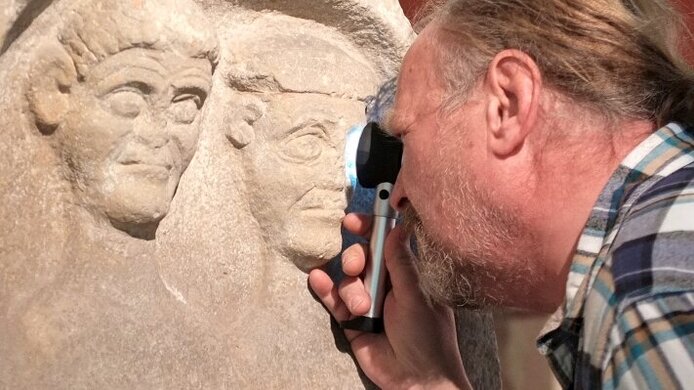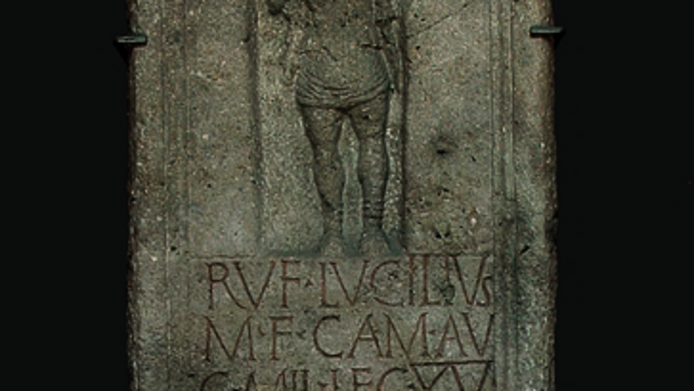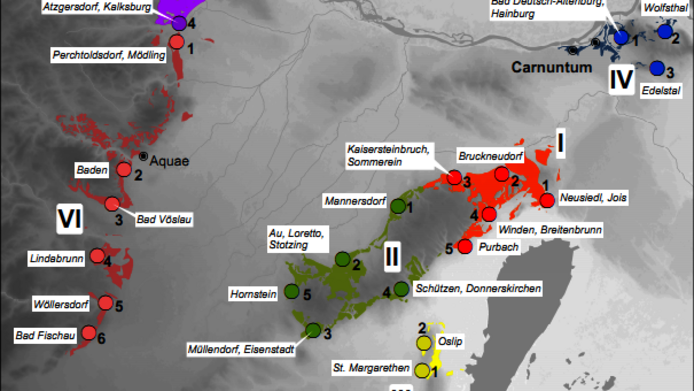Roman stones tell us about their origin

Stone monuments from Roman times found in Austria have been talking to archaeologists from the moment they were excavated. What exactly they communicate, however, depends on the questions put to them. What, for instance, does the grave stele tell us, erected in memory of the soldier Rufus Lucilius around 44 AD on the Carnuntum street of tombs? It conveys surprising facts, because it is known that at the time when Roman troops arrived in the Vienna Basin at the beginning of the first century AD, stone was not used there even as a building material for houses. The “CarVin” research project brings together an interdisciplinary team under the auspices of the Institute for the Study of Ancient Culture of the Austrian Academy of Sciences. The researchers are exploring the provenance of the stones found and the archaeological context of monuments from the Roman period.
Sophisticated warehouse logistics
“Not every type of rock is suitable for every utilisation,” emphasizes principal investigator Gabrielle Kremer. A finely carved statue requires a different raw material than a roughly hewn wall block. In addition, transporting stone takes quite an effort, especially if it had to be done by ox cart instead of by ship on a river. When the Romans conquered the Vienna region, they not only scouted out a suitable storage site on the frontier formed by the River Danube, but also engaged in advance exploration of suitable raw material deposits in order to be able then to roll out their logistics and well-evolved cultural techniques. The stone monuments from Carnuntum and Vindobona erected at the time of the Roman occupation, for instance, are not only of cultural and historical significance, but they also testify to the economic, social and technological transformations experienced in the region. Sites and people there that could ensure the supply and processing of stone building materials probably found themselves in much greater demand from that time onward.
Scrutinizing the stones
The team of researchers from the Academy of Sciences, the Vienna University of Technology (TU Wien), the Geological Survey of
Austria (GBA), the Wien Museum, the City of Vienna’s Department of Urban Archaeology and the University of Vienna examined a total of 942 stones used for a variety of purposes, including square stone blocks found in the fortress wall, cult monuments, grave steles and milestones, millstones and stone vessels. In the project, which is funded by the Austrian Science Fund FWF, archaeologists cooperated with geologists to develop a precise terminology for the stone material and an identification key for finds and the surrounding context from Carnuntum and Vindobona (today Vienna). “Of course, earlier archaeological digs always recorded the materials found, but the differentiation was rather summary and only distinguished between limestone, sandstone, marble, etc. With the support of our rock experts, we can now distinguish seven local and regional quarry regions, and for many finds we can narrow down the provenance of the material very precisely,” explains Gabrielle Kremer. The completed identification key can be applied with a 10x magnifying glass and will also help detect forgeries more easily in the future. For developing the classification, the researchers had to take several samples from the ancient finds and examine them thoroughly.
The cultural area and its building material
For the high-quality limestone from the Leitha Mountains - used for statues and cult monuments, among other things - the quarrying sites cannot be narrowed as precisely as for the functional building material from the
western edge of the Vienna Basin. “This springs from the origin of the Leitha limestone. Oceanic sediments change in composition within very small areas. Moreover, the quarries continued to be used after the Romans left. Actually, we have identified only one site where we identified what we believe are traces of ancient quarry operations,” says Kremer. Nevertheless, matching the stone with the seven quarry regions results in interesting distribution patterns that allow the researchers to draw conclusions about the organization of construction processes, stonemasons' workshops, trade relations or transport logistics. The project not only involved diverse expertise and finds, but also laser scanning and aerial photo data to identify logistic nodes such as settlements, roads and quarries. The analysis of the shortest and most cost-effective land routes between quarry, workshop and installation site will be completed soon. It will then be possible to also determine the area covered by a cultural region on the basis of the provenance of material.
Stone by stone the fortresses took shape
A permanent fortress of the XVth Legion existed in Carnuntum from about 40 AD. A first stone wall encircling the fortress was built there soon after 100 AD. The same is true of the legionary fortress at Vindobona. In Carnuntum, concrete information on the dating and origin of the building material was furnished especially by the gravestones of the legionaries. The stele dedicated to the Upper Italic soldier Rufus Lucilius, who is depicted in full military dress, was hewn in limestone from the nearby Hainburg Mountains. But the quarries in the Leitha Mountains southwest of Carnuntum were also already in operation at the beginning of the Roman presence. Although there was certainly an exchange of information between the two fortresses located on the Danube, the troops stationed in Vienna operated their own local quarries (among others in Nußdorf, Heiligenstadt, Perchtoldsdorf). The Leitha limestone, which was brought from a greater distance, was mainly used for sculptured monuments. The researchers also identified a quarry near the town of Scarbantia, today's Sopron, in Hungary, whose material was not used further north. Something else has become evident: no matter how diverse the ethnic origins of the soldiers assembled in the legions over the centuries may have been, the stonemasonry workshops of Carnuntum and Vindobona soon developed their own unmistakable style. The new results will be added to the Corpus Signorum Imperii Romani as stone monuments of the Roman province of Pannonia and further investigations will follow.
Personal details Gabrielle Kremer is an archaeologist at the Institute for the Study of Ancient Culture of the Austrian Academy of Sciences. One of the focus areas of her research is the analysis and comparative evaluation of stone monuments of the Roman provinces as historical sources. She studied archaeology, ancient history and communication sciences at the Ludwig Maximilian University of Munich and the University of Vienna. She wrote her doctoral thesis on tomb structures in Noricum and has been collaborating with the Archaeological Museum in Carnuntum for many years. In 2017, she was appointed head of the working group "Religion and Society".
More information







